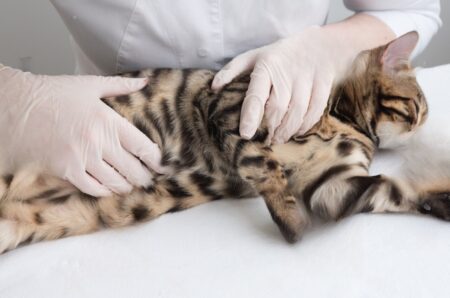Rabies in Cats: Signs To Look For
Rabies is a deadly viral disease that affects mammals, including cats. It is caused by the rabies virus and is usually transmitted through the bite or scratch of an infected animal. Rabies can also be spread through contact with the saliva or nervous tissue of an infected animal.
If a cat is infected with rabies, they may show a variety of signs and symptoms. These can vary depending on the stage of the disease and can mimic other illnesses. It is important for cat owners to be aware of these signs and seek immediate medical attention if they suspect their cat may have rabies.
In this article, we will discuss the signs of rabies in cats and provide information on how to prevent and treat this deadly disease.
Rabies in Cats: Signs To Look For
Rabies is a viral disease that affects the nervous system of animals, including cats. It is important for pet owners to know the signs of rabies in cats so they can seek immediate veterinary care and prevent the spread of the disease. Here are some signs to look for:
- Behavior changes: One of the most common signs of rabies in cats is a sudden change in behavior. Cats may become either abnormally aggressive or unusually withdrawn and lethargic. They may also show signs of restlessness and aimless wandering.
- Excessive drooling and difficulty swallowing: Rabies affects the nerves that control the muscles of the face and throat, leading to excessive drooling and difficulty swallowing. Cats with rabies may also have a hard time eating and drinking.
- Vocalization: Rabies can also affect the nerves that control vocalization, causing cats to make strange noises or become unable to meow.
- Paralysis: As the disease progresses, cats may become partially or completely paralyzed due to the virus attacking the nerves and muscles.
- Seizures: In some cases, cats with rabies may experience seizures due to the virus affecting their brain.
- Hypersensitivity to touch: Cats with rabies may also exhibit increased sensitivity to touch and may react strongly when touched or petted.
- Changes in pupil size: Another sign of rabies is changes in a cat’s pupils. They may become either dilated or constricted, and the reaction to light may be abnormal.
- Fever and lethargy: As the virus progresses, cats may develop a fever and become increasingly lethargic.
- Incoordination and staggering: Rabies can affect a cat’s coordination and balance, causing them to stumble or have difficulty walking.
What Is Rabies in Cats?
Rabies is a viral disease that affects the nervous system of cats and other mammals. It is caused by the rabies virus, which is transmitted through the saliva of an infected animal, usually through a bite.
If left untreated, rabies can be fatal to cats and can also be transmitted to humans. Therefore, it is important for cat owners to be aware of the signs and symptoms of rabies and to take preventative measures to protect their cats from this disease.
How Can a Cat Get Rabies?
- Bitten by an infected animal: The most common way a cat gets rabies is by being bitten by an animal that is carrying the virus. This can include wild animals such as raccoons, skunks, foxes, or bats. These animals can transmit the virus through their saliva, and if a cat is bitten, the virus can enter their body and cause an infection.
- Contact with infected saliva: Rabies can also be transmitted when an infected animal’s saliva comes in contact with a cat’s mucous membranes or an open wound. This could occur if a cat comes in contact with the saliva of an infected animal while grooming, or if an infected animal’s saliva gets into a cat’s scratch or wound.
- Eating an infected animal: Some cats may develop rabies after eating an infected animal, such as a mouse or bat. In this case, the virus can be transmitted through the ingestion of the infected animal’s tissue.
- Maternal transmission: Rarely, a mother cat can pass the virus on to her kittens while they are still in the womb or through her milk. This is known as vertical transmission and is most likely to occur if the mother cat has been bitten by an infected animal.
- Exposure to infected blood or tissue: Rabies can also be transmitted if a cat comes into contact with infected blood or tissue. This can happen, for example, if a cat is involved in a fight with an infected animal and comes into contact with their blood.
Causes of Rabies in Cats
The most common cause of rabies in cats is being bitten by an infected animal, such as a bat, raccoon, skunk, fox, or stray cat. Rabies is most often transmitted through the saliva of an infected animal, but it can also be spread through a scratch from an infected animal or if the saliva comes into contact with a cat’s open wound or mucous membranes.
The virus enters the cat’s body through the bite wound or other opening and then travels through the nerves to the brain. Once in the brain, the virus multiplies and spreads to other organs. The virus can take anywhere from a few weeks to several months to reach the brain, so it is not uncommon for a cat to show symptoms of rabies a few weeks after being bitten.
Another cause of rabies in cats is the transmission of the virus from mother to kitten during birth or through infected milk. This is known as congenital rabies and is rare but possible.
A cat can also develop rabies if it ingests the flesh or brain of an infected animal. This form of rabies is known as paralytic rabies.
SEE ALSO: How Big Do Teacup Maltipoos Get?
What Are The First Signs of Rabies in A Cat?
The first signs of rabies in a cat can vary, but typically the symptoms start to appear within 1-3 months after the cat has been exposed to the virus.
The most common early signs of rabies in a cat include:
- Behavior changes: One of the first signs of rabies in a cat is changes in their behavior. They may become more aggressive or irritable, or they may become unusually docile and unresponsive.
- Increased vocalization: An infected cat may start to meow, growl, or hiss more frequently, even without any apparent trigger.
- Loss of appetite: Rabies can cause a cat to lose interest in food and water, leading to weight loss and dehydration.
- Difficulty swallowing: As the infection progresses, a cat may have difficulty swallowing and may drool excessively.
- Seizures: Rabies can cause seizures in cats, which may present as sudden shaking or jerking movements.
- Paralysis: As the virus attacks the nervous system, a cat may become paralyzed, particularly in the hind legs.
- Uncoordinated movements: An infected cat may have difficulty walking or may appear uncoordinated in their movements.
Signs of Rabies in Cats’ Eyes
- Dilated Pupils: One of the most common signs of rabies in cats is dilated pupils. When a cat has rabies, the virus attacks the nervous system, which can cause changes in their pupils’ size and shape. Dilated pupils can also occur due to other health problems, so it is essential to consult a veterinarian for a proper diagnosis.
- Red or Bloodshot Eyes: Rabies can cause inflammation of the eyes, leading to red or bloodshot eyes. This is due to the virus attacking the nervous system and causing irritation and inflammation in the eyes. It is essential to seek medical attention if you notice this change in your cat’s eyes.
- Third Eyelid Showing: The third eyelid, also known as the nictitating membrane, is a translucent membrane that helps protect and lubricate the eye. In a healthy cat, it is not usually visible. However, when a cat has rabies or another illness, the third eyelid may become visible. This is a sign of illness and warrants immediate veterinary attention.
- Discharge from the Eyes: Rabies can cause an increase in mucus production, leading to a discharge from the eyes. The discharge may be clear, cloudy, or yellowish and can be present in one or both eyes. If you notice any discharge from your cat’s eyes, it is essential to have them examined by a veterinarian.
- Squinting or Blinking: If your cat is squinting or blinking frequently, it may be a sign of discomfort or pain in their eyes. This can be caused by inflammation or irritation due to rabies. If your cat is continuously squinting or blinking, it is important to have them evaluated by a veterinarian.
- Hydrophobia (Fear of Water): Rabies can cause strange behaviors in cats, one of which is hydrophobia or fear of water. This is due to the virus affecting the brain and causing neurological changes. If your cat suddenly becomes afraid of water or refuses to drink, it could be a sign of rabies.
- Changes in Vision: Rabies can affect a cat’s vision, causing them to have difficulty seeing or to become blind. If you notice your cat bumping into objects or struggling with depth perception, it could be a sign of rabies.
How Veterinarians Diagnose Rabies in Cats
The only definitive way to diagnose rabies in a cat is through a post-mortem examination of the brain tissue.
Rabies in Cats Transmission to Humans
Rabies is a viral disease that can be transmitted from animals to humans, and cats are one of the most common carriers of the virus. The virus is primarily spread through the saliva of an infected animal, usually through a bite or scratch. It is important for cat owners to understand the risks of rabies and take necessary precautions to protect themselves and their families. The transmission of rabies from cats to humans is rare, but it is still a serious concern.
Treatment for Rabies in Cats
Rabies is a fatal viral infection that affects the nervous system of cats and other animals. There is no cure for rabies once symptoms appear, so it is important to take preventative measures such as vaccinating your cat against the virus.
If your cat has been exposed to a rabid animal, the first step is to isolate them from other pets and humans. This is important to prevent the spread of the virus. The next step is to seek immediate veterinary care. The veterinarian will perform a physical exam and gather information about the cat’s history of vaccinations and potential exposure to the virus.
If your cat is up-to-date on their rabies vaccine, they will likely only need a booster shot. However, if they are overdue for their vaccine or have never been vaccinated, the veterinarian may recommend quarantine for observation. This is to ensure that the cat does not develop symptoms of rabies.
If your cat does develop symptoms of rabies, treatment options are limited and the outcome is unfortunately fatal. The veterinarian may recommend euthanasia to prevent the suffering of the cat and to prevent the spread of the virus to other animals and humans.
Prevention of Rabies in Cats
- Vaccinations: The most effective way to prevent rabies in cats is through regular vaccinations. In many countries, including the United States, rabies vaccinations are mandatory for all cats. Kittens should receive their first rabies vaccine at around 12-16 weeks of age, with booster shots every 1-3 years.
- Avoid contact with wild animals: Cats should be kept indoors to reduce their risk of encountering wild animals. If they do go outside, they should be supervised and kept away from areas where wild animals are known to roam.
- Control stray animals: Stray cats and dogs can also carry rabies, so it is important to control their population and keep them away from domestic pets.
- Prevent access to bats: Bats are one of the most common carriers of rabies. Cats should be kept away from areas where bats may roost,
such as attics and basements.
SEE ALSO: Do Birds Have Ears?
FAQs
Q. How do I know if my cat has rabies?
A. There are a few signs that may indicate that your cat has rabies, including changes in behavior such as increased aggression or fearfulness, difficulty walking or paralysis, excessive salivation or “foaming” at the mouth, and changes in vocalization.
Q. How long does it take to see signs of rabies in a cat?
A. The time it takes for signs of rabies to appear in a cat can vary, but it usually takes between 3-12 weeks after exposure to the virus.
Q. What does a rabies-infected cat look like?
A. A rabies-infected cat may display a variety of symptoms including aggressive behavior, excessive salivation, difficulty swallowing, drooping head and difficulty moving, and changes in vocalization.
Q. How common is rabies in cats?
A. Rabies in cats is relatively rare, with only a few reported cases every year in the United States.
Conclusion
In conclusion, rabies is a serious viral disease that can affect cats and even be transmitted to humans. It is important for cat owners to be aware of the signs and symptoms of rabies in cats in order to seek prompt medical attention and prevent the spread of the disease. Some common signs to look for include changes in behavior or activity level, abnormal vocalizations, excessive salivation, and difficulty walking or standing. If your cat displays any of these symptoms, it is important to seek veterinary care immediately. Additionally, it is crucial to keep cats up to date on their rabies vaccinations to prevent infection. Taking preventative measures and being aware of the signs of rabies can help protect both cats and humans from this deadly disease.


